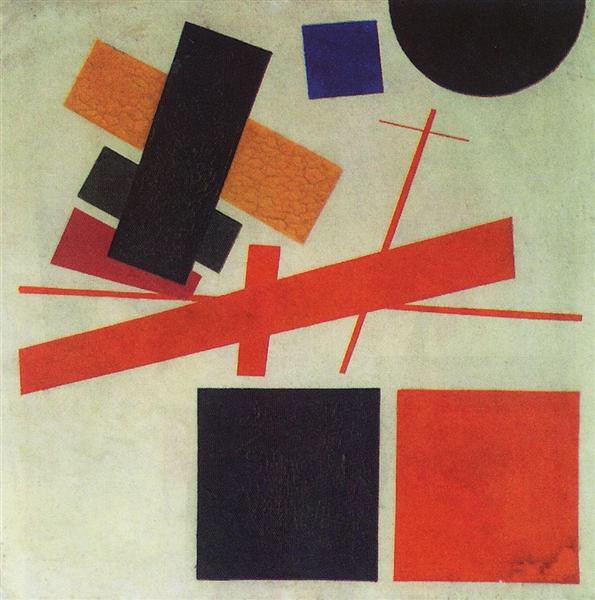“Супрематизм” (Suprematism), 1915, Kazimir Malevich

Kazimir Malevich (1878-1935) is a Russian avant-garde artist. He is well-known for “Suprematism”–a manifesto on “supremacy of pure feeling” that will be attained by “ignores the familiar appearance of objects”. His paintings are also called non-objective art. In 1915, he displayed his suprematist composition for the first time at The Last Futurist Exhibition of Paintings 0.10, in Petrograd (St.petersburg).
One of the compositions in “0.10” Exhibition is Suprematism that presents two squares in black and red, black semi-circle on the top, tilted blue square, and some basic geometry shapes in red, yellow and dark green colors, from the center of canvas to the top. These figures so easily catch our eyes, primarily, because of the contrast white background of this painting. As Malevich suggests, in the Suprematism manifesto, square does not mean “empty”, but a form of nonobjective feeling. Some basic geometry shapes present the feeling, while the white background is “the void beyond this feeling” or sometimes is seen as the infinity.
As Malevich explains in his manifesto, he refuses art that aims to serve the state or religion. He believes that feeling is the only source of creative work. Feeling has strong power to find a way out in a form in which it can be communicated. However, in Suprematism, the feeling does not refer only to the emotions of its creator. It expresses the spirit of the world.
For Malevich, the state of affairs in art is as same as in technology. Both of them prioritize the method of representation of the world. Like an airplane, as Malevich says in Suprematism manifesto, it emerges not to serve practical values, such as carry business letters, but from ‘a yearning for speed’. The invention of the airplane is driven by “the yearning of speed” that finds an external form.
The basic geometric shapes can also be seen as a postulate in mathematics, a single algebraic proposition, the main assumption in science that connects humans to the fundamental elements of natural worlds.
Dr. Steven Zucker and Dr. Beth Harris told in Khan Academy, Malevich’s Suprematism challenges the naturalism way of painting that is often associated with the bourgeois society in the 19th century. The pure geometric shapes of Malevich aims to eliminate all cultural references so everyone can understand and involve in art.
Although Malevich wants to separate his artwork from its environment or social-political circumstances, his Suprematism did not birth in the vacuum atmosphere. Suprematism was born in the period of the Russian Revolution that superseded the absolute Tsar with the communist order. The communist revolution brought new hope and promise of equality in society. The intention to remove all cultural references in Malevich’s painting is related to this hope. Malevich’s Suprematism, then, is not only a counter in the way of painting but also against the social condition of absolutism power. As Zucker and Harris suggest, Malevich is one of the 20th-century artists who intend to change the corrupt regime and build a better society.

